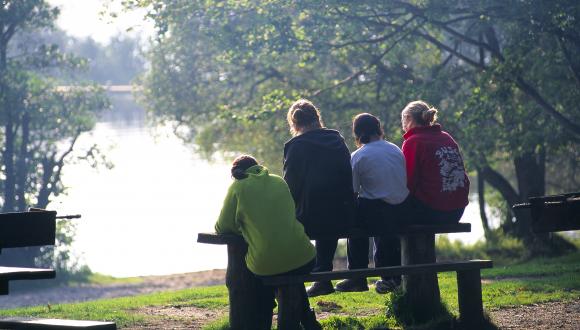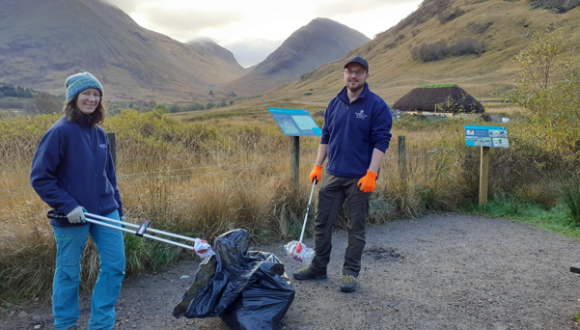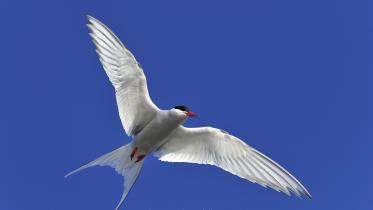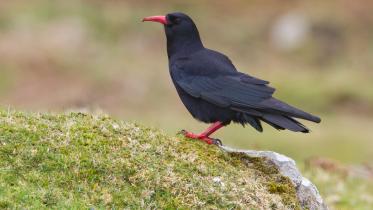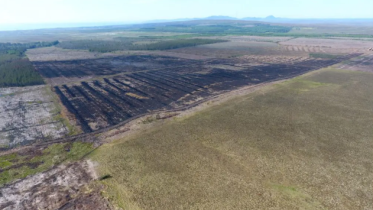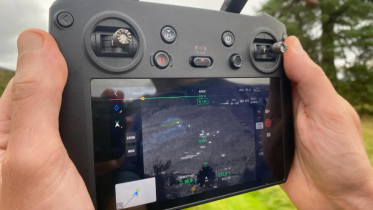Better Places Green Recovery Fund - INFORMATION FOR APPLICANTS
Published: 2021
Introduction
Scotland’s countryside has never experienced such high levels of use by the public. 2020 has seen a pandemic which has changed the public’s use of Scotland’s countryside and outdoor places. Initial lockdown restrictions where followed by phased relaxations and an influx of domestic visitors from the UK and locally in Scotland over the extended summer months. Day visitors and over-night stays, first time visitors and returners all at a time when trends were already indicating an increase in visitor activity and numbers before the pandemic hit.
There are considerable benefits for visitors, businesses and local communities from more people enjoying the outdoors and connecting with nature, with the development of a sustainable tourism sector and as a key part of a fair transition to net zero and a nature-rich Scotland. At the same time, there are also negatives with more people in places not ready or able to cope with such high numbers often over a sustained period of time, and with elements of anti-social activity mixed in, resulting in impacts on communities, other people’s enjoyment and nature.
Key issues and pressures at “hot spot” sites this year, 2020, include a lack of capacity for the numbers of people who visited, associated parking and traffic management challenges; very high and concentrated levels of motorhome and camping activity; and widespread issues with litter, toileting, fires and BBQs. These problems are often linked to insufficient or no infrastructure and no associated services such as rangers. They can result from poor awareness of responsible behaviour and in some cases active disregard for it. In some places, visitor numbers may simply be too high to be sustainable. Many of these issues and pressures peak at weekends and during holiday times and during good weather. Popular locations include where roads or parking is close to the water’s edge such as beaches, lochs, rivers and reservoirs, or in areas of spectacular scenery such as our National Scenic Areas and National Parks. Proximity to where people live is a factor especially for regional and country parks, local nature reserves and urban parks.
To help prepare for 2021 and beyond, funds are available to help plan for the future, and identify ways to accommodate visitors in a low impact and sustainable way, encourage their enjoyment and understanding of our special places, making connections with nature and realising the many benefits that Scotland’s countryside, coast and green spaces provide.
Better Places Fund
This fund has been set up by NatureScot to help communities and destinations start, or develop further, pro-active visitor management in “hot spot” locations. The fund will offer financial support to undertake the preliminary stages of visitor management planning, which we anticipate as being largely around scoping of the issues and interests. The fund will also support the further development or review of any existing plans, as well as feasibility and design work for infrastructure solutions and measures.
The fund will prioritise areas in Scotland which suffer from excessive visitor management pressures including those with capacity issues, inadequate or no infrastructure and services, remote locations, erosion and land-based impacts, anti-social behaviour. The fund also recognises that areas differ across Scotland and scales of planning and the interventions required need to fit the local circumstances (keeping in mind the potential for displacement of issues). Liaison with the local authority and/or National Park Authority should be a key part of this process, to ensure alignment with any other strategic visitor management activity.
We are also using the fund to:
- Test how we better support capacity building and skills development for visitor management planning
- Support a visitor management pathway leading to further action and resources such as infrastructure development (currently funded through the Visit Scotland Rural Tourism Infrastructure Fund)
- Share good practice and develop useful advice and guidance on visitor management approaches used to tackle common issues e.g. case study examples, designs and management measures.
The fund will support NGO or community-led activity costing between £5,000 and £20,000.
Due to the current circumstances and timescales available to deliver this year’s fund, we anticipate that this initial scoping work will be largely desk-based, but should be used to inform what is required to progress to a full visitor management planning process with wide engagement and consultation once circumstances allow.
This is a challenge fund with a rolling assessment and approval process. Applications can be submitted at any time up to 29 January 2021 (midnight).
All work must be completed by 31 March 2021 at the latest, with all claims made by 15 April 2021.
What kind of activity will we fund?
The fund is looking to support action in the areas of Scotland which are suffering the most countryside related visitor pressures. The fund will act as a catalyst for further planning and action, and aims to support both long and short term outcomes:
Essential outcomes
- Visitor management impacts and opportunities have been identified and a start on how to address them has been made.
Additional outcomes
- Communities and interested parties have a mechanism or way forward to help develop solutions to address visitor impacts and improve local and visitor experiences and place.
- Designed solutions or options are prepared which lead to improvements to places, including green/blue space, which people visit and live beside.
- Communities, including landowners, land managers, businesses and visitors are motivated or empowered to help develop plans and action in a collaborative way.
- Skills and training needs for visitor management have been identified, with the use of volunteers including rangers also considered.
- Places under pressure and suffering negative impacts from increased visitation are managed in a sustainable way that supports responsible enjoyment.
- Solutions provide sources of income from visitors to help sustain local services
- Solutions are explored and developed that encourage a low carbon impact, particularly in areas prone to high levels of car based access.
- NatureScot and its strategic partner agencies, including Scottish Government, are better informed about local requirements for managing impacts and developing opportunities linked to green tourism.
Who can apply?
Applications are invited from constituted organisations, including registered charities, trusts and community groups. Where applications are received from partnerships or organisations working collaboratively, a lead applicant must be identified.
Applications must be for activity or project delivery in Scotland.
Applications from the following groups will not be eligible.
- Local authorities and other public sector organisations
- Academic institutes
- Private individuals and companies (only eligible where there is significant public benefit)
Examples of the kind of activities we could fund:
Visitor management scoping and evidence gathering:
- Undertake an “assets” audit to identify current capacity and provision for visitors and key environmental or community constraints.
- Prepare a visitor profile gathering evidence on who visits, from where, when, why, motivations, demands/needs etc. and any emerging trends/changes.
- Gathering and analyse evidence of visitor pressures, issues, conflicts and impact, including local intelligence, user data, traffic counts, visitor surveys, safety issues, erosion data etc.
- Identify interest groups/stakeholders including landowners and land managers, community, business, visitor interests, organisational interests etc. and prepare an engagement plan.
- Policy review and assessment to identify related plans and local activity such as community action plans, visitor destination/tourism plans, designated or protected areas, active travel developments, core paths, forestry plans, car park strategies etc.
- Undertake digitally based stakeholder engagement activity.
Developing options and designs for countryside/green infrastructure and/or services:
- Design of countryside/green infrastructure and/or services solutions and options including preparation of concept drawings, technical drawings, detailed plans, feasibility assessments as part of a holistic approach to addressing issues.
- Prepare signage and/or local information/interpretation approaches that support visitor management priorities as part of a holistic approach to addressing issues at “hot spots” locations.
- Skills and training development needs for stakeholders and volunteers
Developing visitor management plans:
- Develop a co-design framework on which to base future sustainable visitor management planning activity involving wider engagement e.g. vision and objective setting, prioritising areas for action.
- Update, improve and/or develop an existing or out of date visitor management plan
- Undertakes an initial SWOT analysis.
What we don’t want to fund
We will not fund:
- The construction of infrastructure such as car parks, toilets, camp sites or paths.
- Activity that is not related to the public’s enjoyment of the outdoors and nature.
- 100% business development proposals (state-aid rules); though we encourage collaborative solutions to visitor pressures that may involve identifying a role for the private sector.
- Projects that do not involve collaborative working with communities of place or interest.
- Projects already being undertaken by the local authority, national park authority or others.
What costs can be funded?
- Consultant or contractor fees and appropriate associated expenses
- Staff costs inclusive of salary, National Insurance and Employee Pension Contributions. The short term nature of the funding is such that we do not anticipate creation and recruitment of new posts. Therefore, it is likely the fund will cover the cost of existing staff having either a proportion of dedicated project time or additional hours.
- Where there are staff costs, organisational and overhead costs (Full Cost Recovery) to cover office accommodation, equipment and running costs, wider staff support (e.g. finance, IT), overall management and project staff training.
- Project staff travel and subsistence to cover staff and any volunteers supporting delivery of the project activities.
- Project evaluation - additional costs for measuring success and evaluating the project. Excludes project staff costs.
- Irrecoverable VAT relating to project costs and activities.
- Management fees - where applications are received from a partnership or organisations working collaboratively.
Funding parameters
The Better Places Fund has an initial budget of £200,000.
- The maximum funding we will award to a project is £20,000
- The minimum funding we will award to a project is £5,000
We will fund up to 100% of project costs, however we prefer to fund projects that have a matched element either cash or in-kind.
You cannot use other sources of NatureScot funding for match-funding such as the Green Infrastructure Fund. Match-funding can be from another government body or other eligible sources such as Lottery funds, charitable trusts, companies or your own funds.
It is a requirement of NatureScot funding that you have any necessary permissions (e.g. landowner permission) and insurance (e.g. public liability insurance) in place before the start of your project. You may be asked to provide evidence of this.
We have provided an eligibility checklist on page 7 to help you assess if you are eligible to apply, projects that do not meet the eligibility criteria will not be considered further.
Evaluation and Reporting
All successful applicants will be required to evaluate and report back on their projects.
We expect you to tell us in your application how you will measure and demonstrate the success of your project including demonstrating if your project aims and outcomes have been achieved.
A short project report must be submitted to NatureScot after completion of the project, briefly describing the activities undertaken, successes and challenges, and outcomes of the project including copies of any plans, reports, designs and any next steps. You should also confirm the amount of funding spent.
Timescales
| - | Date |
|---|---|
|
Opening date for applications |
10 December 2020 |
|
Closing date for final applications |
29 January 2021 (midnight) |
|
Application decisions and funding offers |
7 January – 7 February 2021 |
| Projects end date |
31 March 2021 |
| Funding claim date |
15 April 2021 |
| Final reports received |
9 April 2021 |
Acknowledgements
You will be required to acknowledge NatureScot support as set out in the guidance: How to acknowledge our support for your project.
Sources of guidance and advice
Management for People 2004 – useful guide, some references are dated but gives a sound basis for visitor management planning.
Scottish Outdoor Access Code – including supplementary information and guidance on camping, fires and litter.
National Access Forum Guidance: Managing informal camping under the Land Reform (Scotland) Act 2003 (guide published in 2016 currently being updated).
Loch Lomond & The Trossachs National Park Authority
Cairngorms National Park Authority
Questions
Any further queries not answered in this Information for Applicants can be sent to [email protected]
Access all application documents on the Better Places Green Recovery Fund page.
Eligibility Checklist
Please use this list of questions to check that your project is eligible before applying.
- Is the application form complete?
- Is the requested grant within the limits (£5,000 to £20,000)?
- Is your organisation eligible for funding (see “Who can apply”)?
- Does your project directly relate to managing visitor pressures and impacts in Scotland’s most under pressure areas?
- Does your project contribute to the essential outcome plus at least one other outcome?
- Will your project end no later than 31 March 2021?
- Is evaluation and reporting included as part of the project?
- Have you included a map of area/location for project activity at a suitable scale and background?
